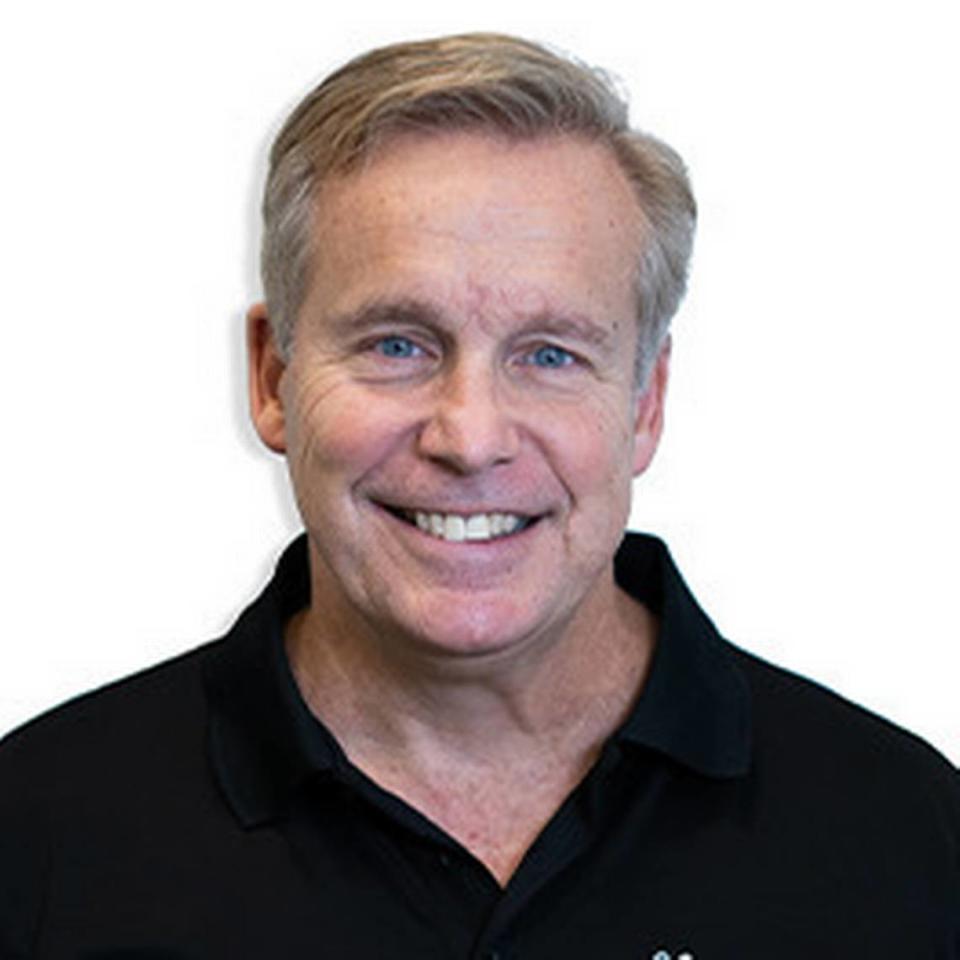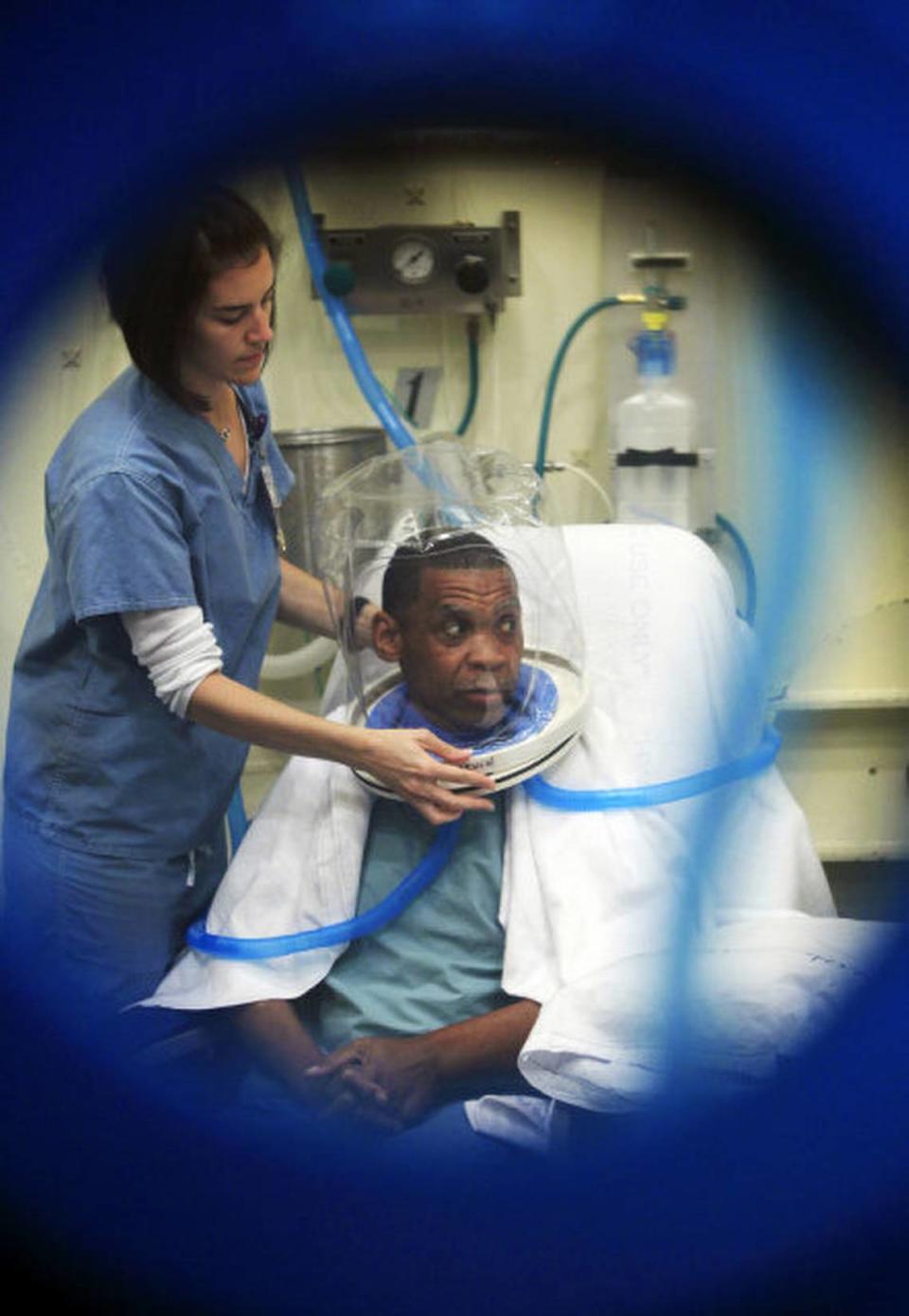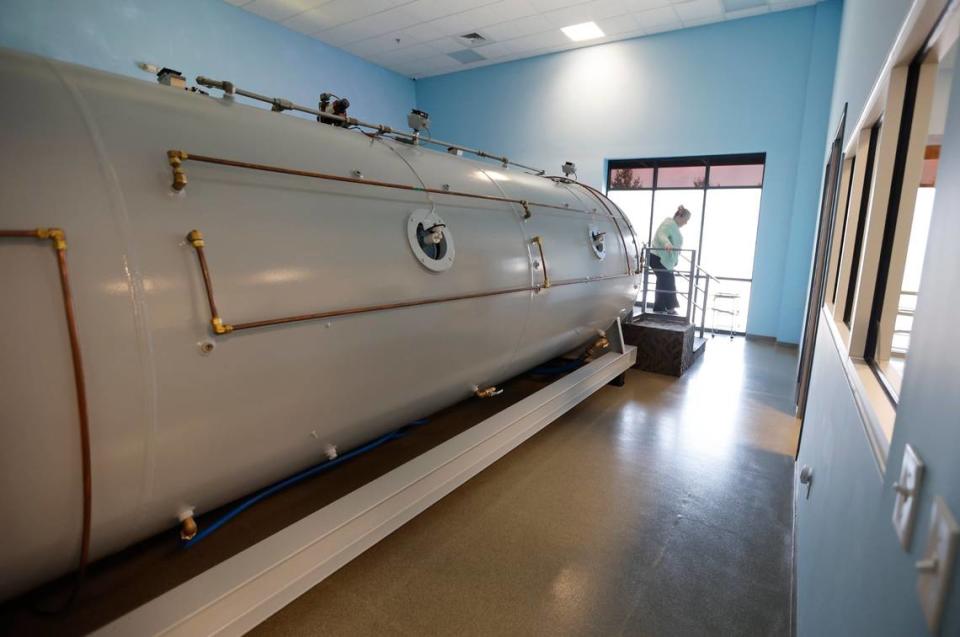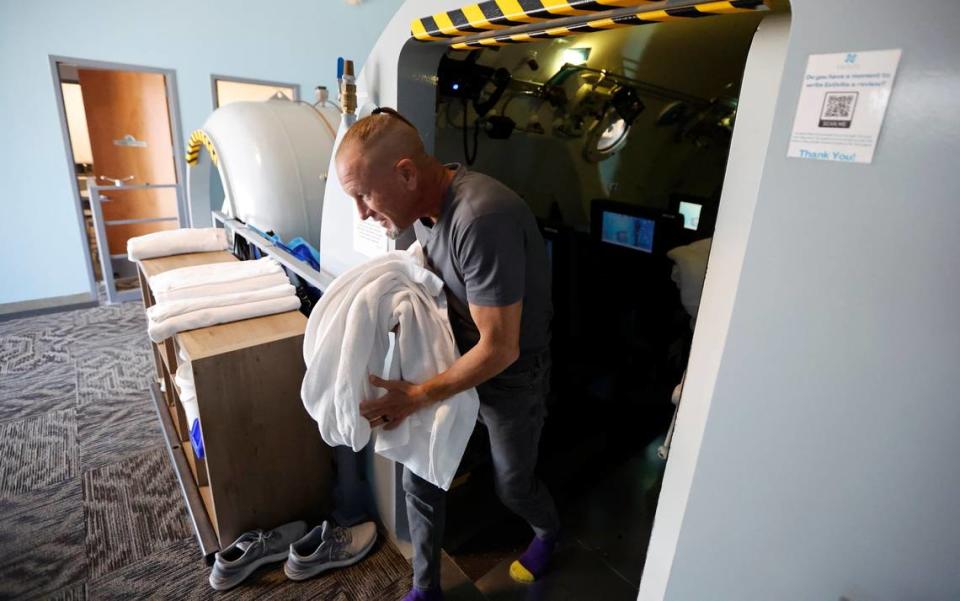Hope for sale: RTP entrepreneur promotes oxygen therapies medical experts don’t embrace
Edward di Girolamo begins with a promise.
“If you give me two minutes, I’ll give you hope.”
In a video streamed on YouTube last year, he stands in front of a news anchor’s desk. Studio lights glint off an American flag pinned to his lapel. His starched collar is unbuttoned, his skin sunkissed. Silvery blond hair sweeps casually across his forehead.
As he does in every episode of the HBOT News Network, di Girolamo extols hyperbaric oxygen therapy, or HBOT as he calls it for short. It’s a medical procedure with striking success in treating people with carbon monoxide poisoning and a few other conditions, and a history of pitchmen claiming it as the solution to the medical crisis du jour.
The technology is now a darling of the booming wellness industry, which offers an array of medical procedures that once were the domain of established healthcare facilities in settings more likely to resemble a spa. Hyperbaric chambers can increasingly be found at businesses offering “off-label” uses, practices not approved by the Food and Drug Administration, at the core of their business model.

Though he doesn’t mention it in the video, di Girolamo started one such business. Extivita, which he opened in 2017 in Research Triangle Park, has advertised hyperbaric oxygen therapy for dozens of off-label uses, from cancer to autism to aging.
But its prime focus is treating traumatic brain injuries, the “signature injury” of the wars in Iraq and Afghanistan, afflicting hundreds of thousands of veterans.
By di Girolamo’s account, HBOT is an “established solution” for relieving symptoms associated with those injuries and with post-traumatic stress disorder, both of which are linked to high rates of suicide.
That’s not the view of the leading society of physicians who specialize in hyperbaric medicine. Or the Veterans Administration. Or the Department of Defense. They say there are promising studies, but far from enough proof.
The large, high-quality studies to date have shown mixed results. While patients with chronic brain injury symptoms reported short-term gains, those in placebo groups did too, suggesting that contact with caregivers may be what delivered the temporary boost, according to a 2021 review of the evidence by the U.S. Veterans Administration.
A structural engineer by training, di Girolamo made a career popularizing new ideas. He has filed at least three patents, founded at least six companies and brought the same audacious spirit to his endeavors as a wellness purveyor. When COVID hit, he sent a proposal to Congress for a massive project to convert the country’s grounded airliners into hyperbaric chambers to treat the expected tidal wave of infections.
Along with some Trump-connected entrepreneurs, including retired Lt. Gen. Michael Flynn, he has been working multiple angles to spread the word that HBOT works for brain injuries and secure funding for it.
North Carolina legislators have so far invested a quarter of a million dollars, with Extivita the sole approved provider of the state-supported program.
On YouTube, di Girolamo has taken his message straight to consumers. He capitalizes on the ever-growing distrust in government and traditional medicine.
“I didn’t just ‘trust the science,’” he says, his fingers in air quotes as he invokes a catchphrase of the COVID era. “I read the research.”
He invites viewers to follow his path.
“It may be more hope,” he predicts, “than you’ve ever gotten outside of prayer.”
MIRACLE MAKERS?
The curing power of hyperbaric oxygen therapy on patients with some conditions is unmistakable, making it tempting to view the devices involved as miracle machines.
Take a classic application: a scuba diver with a severe case of the bends, which can lead to paralysis.
“You have somebody with paralyzed legs, you put them in the chamber a few times and then they can walk,” said Dr. Richard Moon, director of the highly respected hyperbaric center at Duke University.

It’s perhaps no surprise then that the technology has inspired almost religious fervor among people desperate for a dramatic and seemingly unlikely turnaround.
But for many conditions, there’s far less proof that it works, said Moon, past chairman of a committee of the Undersea and Hyperbaric Medical Society that reviews the scientific evidence for different applications of hyperbaric oxygen therapy. The FDA and insurers generally defer to the society’s conclusions about whether sufficient data supports routine use of HBOT for a given condition.
While hyperbaric boosters generally point to personal testimony and case series as proof, scientists on the committee want to see more rigorous evidence. Especially favored are results from large studies that compare a treatment’s effects on patients who receive it to those who receive a placebo that looks like the therapy instead.
For some of the most heavily promoted uses of hyperbarics, including traumatic brain injuries, cerebral palsy and autism, those studies have not corroborated the promising small-scale findings, published reviews of the evidence show.
The lack of high-quality scientific evidence has not kept the businesses that promote the therapy for unapproved conditions from becoming akin to pilgrimage sites.
In the 2000s, for example, a hyperbaric facility in North Carolina’s Blue Ridge Mountains called Miracle Mountain Inc. drew thousands of patients, particularly children with devastating neurological conditions, from across the world.
Because hyperbaric oxygen therapy is not approved for cerebral palsy and other neurological conditions, these children couldn’t receive HBOT in hospitals, which rarely open chambers for non-sanctioned care.
Since insurers generally won’t cover the cost of unapproved uses, parents paid Miracle Mountain out of pocket — $3,000 for 40 sessions in a chamber, the Winston-Salem Journal reported in 2002.
Miracle Mountain is now defunct, but parents of sick or injured children continue to shell out large sums to North Carolina businesses positioned to capitalize on the demand.
A Fayetteville family whose son suffered a severe birth injury wrote on GoFundMe in 2014 that their son receives hyperbaric oxygen therapy, or HBOT, five days a week at $150 a session.
A family from Monck’s Corner, South Carolina, sought help through the fundraising site to pay an Asheville clinic more than $10,500 for an initial treatment for their 3-year-old son with autism.
“If you can not give, I still need your help,” the boy’s parents wrote in April last year. “We need your prayers. Please join us in praying for a breakthrough, for a firm foundation, that Waylon would walk to the end of the earth proclaiming the name of Jesus because of what He’s done.”
These businesses walk a regulatory tight rope. While clinicians may use their discretion to prescribe treatments that lack FDA approval, federal law bars advertising services that are unsupported by reliable scientific evidence.
Enforcement has been limited. But this new breed of hyperbaric clinic has occasionally come under regulators’ crosshairs.
In February last year, the Federal Trade Commission sent a warning letter to Ohana Hyperbarics, a Washington company owned by one of di Girolamo’s co-authors in the white paper that suggested turning aircraft into COVID treatment chambers.
The FTC found that Ohana’s claims about COVID treatments were not substantiated by “competent and reliable scientific evidence.”
“You must immediately cease making all such claims,” the letter stated.
‘THIS IS MY MINISTRY’
Like Miracle Mountain’s late founder, Bob Hartsoe, who initially bought a hyperbaric chamber for a grandson with cerebral palsy, di Girolamo evangelizes with the fervor of a true believer.
“This is my ministry,” he said during an interview with The News & Observer.

Di Girolamo first heard about the technology in 2014, he said, from an Army colonel in Afghanistan, where he was working to design new military tents out of steel.
The colonel told him HBOT could help stem the military suicide crisis, but the FDA had approved its use for only 13 conditions, not including traumatic brain injuries or PTSD, di Girolamo said.
Di Girolamo was outraged. He knew veterans who had taken their own lives, and he was persuaded by his follow-up research.
“There is no snake oil here, so why is it being blocked?” he asked himself.
He developed a few theories. One he calls the “rice bowl effect,” where people already in the medical industry protect their income. Another is that doctors are not sufficiently educated in the therapy’s benefits. The third: businesses offering HBOT had low profit margins because no one can patent oxygen.
Soon he was on the case, flying to Albuquerque to attend a conference of Hyperbaric Medicine International, a group whose leaders have military ties and a mission to expand the accessibility of HBOT.
The nonprofit positions itself as an alternative to the Undersea and Hyperbaric Medical Society, which sets standards in traditional hyperbaric medicine. It certifies providers, treatments and devices, and lobbies insurers and medical schools to embrace wider uses of HBOT.
Di Girolamo now sits on its board, along with Flynn, the indicted and pardoned former national security advisor, and Gina Loudon, co-chair of Women for Trump.
INDUSTRIALIZING HBOT
Within two years of learning about HBOT, di Girolamo founded a company to sell it.
He staked out a spot for the clinic in a warehouse in RTP adjacent to some of his other businesses, The Steel Network, a steel framing manufacturer, and Basnight & Sons, which sells commercial doors and hardware.
Di Girolamo offered a tour to Jim Hooker, a Greenville-based veteran’s advocate with a longstanding interest in HBOT, before the walls were even up.
“He said this is where we’re going to build it, right here,” motioning to a cavernous space, Hooker said.
Most clinics that operate independent from hospitals use chambers that treat one person at a time. But di Girolamo planned to go bigger. He purchased two chambers, one that fits six people and another that fits eight.
Di Girolamo offered HBOT to veterans for $75 a session, half the normal price, with The Steel Network providing a subsidy, he said.
Hooker said di Girolamo asked him to bring the clinic patients and the partnership seemed ideal to him. “We were of one mind,” Hooker said.
The 2017 application to trademark the name Extivita spelled out di Girolamo’s other big plans: designing and selling hyperbaric chambers, technical and business consulting, training.
The goal, he later wrote, was “industrializing the hyperbaric oxygen industry.”
FRIENDS IN HIGH PLACES
Prompted by new research involving the Israeli military, the Undersea and Hyperbaric Medical Society considered whether to add chronic traumatic brain injury to its list of approved HBOT indications.
The Hyperbaric Oxygen Therapy Committee held two meetings that interrogated the evidence before deciding against it.
Too many questions remained unanswered, Moon said. One large-scale study with positive results isn’t enough. Research findings must be reproducible.
The careful review was motivated by both good science and the specialty’s unenviable historical association with “quacks,” said John Peters, executive director of the medical society.
Despite skepticism at that society, lawmakers in North Carolina and other states are endorsing HBOT to treat traumatic brain injuries and PTSD.
In 2019, this state’s lawmakers unanimously approved a bill that Hooker says he authored. It “authorized” hyperbaric oxygen therapy for those conditions, making North Carolina the one of the first states in the country to do so.
Dr. Greg Murphy, a urologist who was then a Republican leader on health policy in the N.C. House, introduced the bill. Because of his reputation, Hooker said, other lawmakers followed his lead.
“When he stood up and said this works, it’s a major treatment for inflammation, it’s not non-invasive and we should make it available for our veterans, it just passed,” Hooker said.
In 2021, at the prompting of Sen. Don Davis, a Democrat who has since been elected to a seat in the U.S. House, state lawmakers allocated $150,000 toward HBOT for veterans.
The following year, after Hooker and di Girolamo met with N.C. House Speaker Tim Moore, lawmakers appropriated another $100,000.
The state-funded program, administered by the Community Foundation for NC East with Hooker coordinating, exclusively sends veterans to Extavita.
As of last year, the state has paid the bills of more than 30 veterans, with some receiving more than one course of a 40-session treatment, Hooker said. Several agreed to participate in video testimonials, which Extivita promotes on social media.
As of September, veterans participating in the state program made up more than a third of Extivita’s patients, said Elena Schertz, the clinic manager. Overall, staff treat about 25 patients a day, she said.

Simon LeMay, a Marine Corps veteran who appears often in Extivita’s promotional materials, credits a dramatic life turnaround to the therapy.
It helped end his suicidal thoughts, save his marriage and get him off the mountain of pills he was taking for pain and PTSD related to military deployments, he says.
“I started getting in the chamber, and my fog started lifting,” LeMay said in an interview with The News & Observer in September. “It absolutely changed my life.”
He’d received two rounds of 40 treatments, he said, plus occasional visits for a “tune up.”
Hooker hopes the testimonials and a report on the group’s outcomes will lead to additional state and private funding. And Murphy, now a congressman, is pushing a federal expansion.
He has repeatedly proposed legislation for a pilot study through the Veterans Administration, with the eventual goal of facilitating veterans being able to access outside providers of HBOT, paid for by the U.S. government.
“There are many instances now where the Veterans Administration pays for outside doctors, because they simply don’t have the doctors within the VA system to take care of patients,” Murphy said in an interview with The News & Observer.
He thinks the scale of the military suicide crisis, roughly 17 deaths a day, warrants this course of action. “We have to stop the carnage,” he said.
NEW HORIZONS
The COVID-19 pandemic presented HBOT boosters with new opportunities.
In June 2020, three months after federal health officials urged Americans to help “flatten the curve,” di Girolamo co-authored the white paper about airplane HBOT.
The vision, which he said he outlined in letters to an array of federal officials, included a role for business alongside aviation, medical and safety experts in setting up airport-based treatment hubs to treat “hundreds if not thousands of patients per day.”
“Together,” the paper concluded, “we can breathe life into our nation, and the world.”
Despite di Girolamo’s lobbying, his airplane proposal never received government approval, nor did his separate application for an emergency use authorization to treat COVID patients at Extivita.
One longtime hyperbaric consultant described the aircraft proposal as “humorous reading.” Severely ill COVID patients couldn’t be loaded onto a plane, for one, said Dick Clarke, owner of National Baromedical Services, based in Columbia, S.C.
He said di Girolamo asked him to endorse his emergency use authorization pitch, but he declined because he found that proposal unrealistic too.
Those rebuffs did not end Extivita’s efforts to profit from the COVID pandemic.
Frustrations with the current medical system, an ever-increasing distrust in institutions and a stew of health-based and political conspiracy theories circulating online had, in the meantime, all helped feed public interest in HBOT.
Extivita has courted COVID long haulers, people suffering from mysterious and debilitating effects months after their initial infection.
Using hyperbaric oxygen therapy to treat this condition remains unapproved. But last spring, Extivita posted on Facebook:
“We hear it over and over again.
We see it over and over again.
We read about it over and over again.
We’re talking about HBOT for COVID long-hauler relief.
It’s a real thing, and it really does work!”
Last summer, the company reported on Facebook that it treats long-haulers every day and restores 99% of them to health.
Journalist Carli Brosseau is a former investigative reporter at The News & Observer.

 Yahoo Movies
Yahoo Movies 
